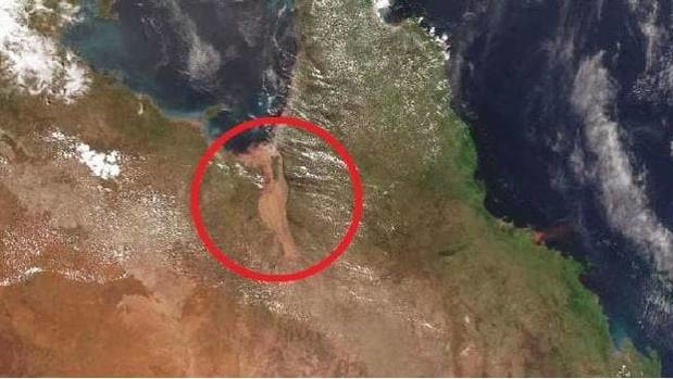
It's a river unlike any in Australia — and a fortnight ago it barely existed.
In northern Queensland, record rain has created an instant "mega river" so immense it can be clearly seen on satellite imagery.
In parts, the Flinders River is now so swollen with floodwater it's expanded to a width of 60 kilometres from bank to sodden bank, news.com.au reports.
On Wednesday, the Bureau of Meteorology said the Flinders "is currently experiencing its most significant flood in at least the last 50 years".
Its turgid, muddy waters are full with floodwater slowly making its way from the state's interior to the Gulf of Carpentaria. The unique geography of the area has exacerbated the impact on the river.
On satellite imagery the massively-widened river can easily be seen in the north of the state.
Also visible is the brown cloudy swirls of stained water emptying into the usually pristine waters of the gulf. The flow is choked with debris, soil and dead cattle.
A major flood warning remains in place for the system.
Sky News Weather channel meteorologist Rob Sharpe told news.com.au the sheer size of the swollen river was why up to half a million cattle had perished — there was simply no dry land for them to get to in time.
"The amount of rainfall has been staggering. Above 500mm of rain spread across a vast region 300km across and 200km north. A year's worth of rain fell in one week and that's a record flood event for the Flinders River.
"The Flinders River system is now a flood plain. This is a mega river making its way up to the gulf."
If you were to pick up the area affected and dump it on populated New South Wales, it would stretch from Sydney, west as far as Bathurst and south to Yass, near Canberra, Mr Sharpe said.
But unlike in NSW, where the water would likely run to multiple rivers lessening the overall impact, the geography of northern Queensland means the vast majority of the water is being funnelled in one direction through the Flinders system.
At 1000km long, the Flinders is the longest river in Queensland and drains a vast area of some 108,000sq km. On its way it passes by towns including Richmond, Hughenden and Julia Creek, many of which have been affected by the floodwater.
Only the final 70km of the river, as it nears the Gulf of Carpentaria close to the small town of Karumba, holds water all year round.
The river crosses a large flat clay pan, and much of its surrounds are ideal for raising cattle. One of the reasons so many have died was the river grew exponentially in size so quickly.
"All that water, half a metre of rain, has flowed into one basin combining into one giant river," Mr Sharpe said.
"The Flinders River basin has now spilt over to the next basin, the Norman River, and that is exceptional.
"The extreme amount of water moving through was why hundreds of thousands of cattle have died. Even if they get to ground, it would have been really boggy and then you add to that the cold, the wet and the wind."
The new Flinders "mega river" will shrink back to its regular size once the remaining floodwater drain its way to the gulf, but that could be well into next week, Mr Sharpe said.
The BoM's advice for those in the vicinity is simple: "If it's flooded, forget it."
On Wednesday, Queensland Premier Annastacia Palaszczuk told parliament rotting carcasses posed a high risk of botulism and Q fever to clean-up crews and water supplies in flooded communities.
Even cattle that survived the horrific two weeks are stranded in floodwater and may still succumb as the dead animals surrounding them contaminate the water they should be drinking.
Queensland Agriculture Minister Mark Furner is on his way to the northwest with a team of biosecurity experts and the army to figure out the best way to dispose of the dead animals.
"The next stage of this exercise is carcass disposal," Mr Furner told the The Courier-Mail. "As it heats up it is becoming a biosecurity matter."
Experts are considering mass burial pits as the best option for Queensland's farmers with the defence force also in talks to bring in heavy machinery to dispose of the cattle corpses.
— Additional reporting by Natalie Wolfe
Take your Radio, Podcasts and Music with you









